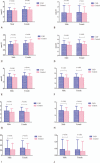The atherogenic index of plasma is a strong and independent predictor for coronary artery disease in the Chinese Han population
- PMID: 28906400
- PMCID: PMC5604669
- DOI: 10.1097/MD.0000000000008058
The atherogenic index of plasma is a strong and independent predictor for coronary artery disease in the Chinese Han population
Abstract
Dyslipidemia is one of the most important factors for coronary artery disease (CAD). The atherogenic index of plasma (AIP), a new comprehensive lipid index, might be a strong marker for predicting the risk of CAD.A hospital-based case-control study including 2936 CAD patients and 2451 controls was conducted in a Chinese population. Traditional lipid parameters were detected, and nontraditional lipid comprehensive indexes were calculated.Compared with controls, CAD patients had higher levels of total cholesterol (TC), triglyceride (TG), and low-density lipoprotein cholesterol (LDL-C). By contrast, the level of high-density lipoprotein cholesterol (HDL-C) was lower in CAD patients. The values of nontraditional lipid profiles, including non-HDL-C, TC/HDL-C, LDL-C/HDL-C, non-HDL-C/HDL-C (atherogenic index, AI), TC*TG*LDL/HDL-C (lipoprotein combine index, LCI), and lg (TG/HDL-C) (AIP), were all significantly higher in the cases than in the controls. The results of Pearson correlation analyses indicated that AIP was positively and significantly correlated with TC (r = 0.125, P < .001), TG (r = 0.810, P < .001), LDL-C (r = 0.035, P < .001), non-HDL-C (r = 0.322, P < .001), TC/HDL-C (r = 0.669, P < .001), LDL-C/HDL-C (r = 0.447, P < .001), AI (r = 0.669, P < .001), and LCI (r = 0.688, P < .001) and was negatively correlated with age (r = -0.122, P < .001) and HDL-C (r = -0.632, P < .001). In the univariate logistic regression analysis, AIP was the lipid parameter that was most strongly associated with CAD, with an unadjusted odds ratio of 1.782 (95% confidence interval: 1.490-2.131, P < .001), for an increase of 1-SD. Multivariate logistic regression analyses revealed that AIP was an independent risk factor for CAD.AIP might be a strong and independent predictor for CAD in the Chinese Han population.
Conflict of interest statement
The authors report no conflicts of interest.
Figures
References
-
- National Center for Cardiovascular Diseases, China. Report on Cardiovascular Diseases in China (2016). Beijing, China: Encyclopedia of China Publishing House; 2015.
-
- Goliasch G, Wiesbauer F, Blessberger H, et al. Premature myocardial infarction is strongly associated with increased levels of remnant cholesterol. J Clin Lipidol 2015;9:801–6. - PubMed
-
- Sniderman AD, Williams K, Contois JH, et al. A meta-analysis of low-density lipoprotein cholesterol, non-high-density lipoprotein cholesterol, and apolipoprotein B as markers of cardiovascular risk. Circ Cardiovasc Qual Outcomes 2011;4:337–45. - PubMed
MeSH terms
Substances
LinkOut - more resources
Full Text Sources
Other Literature Sources
Medical
Miscellaneous


